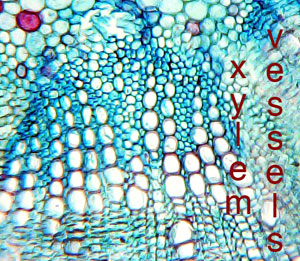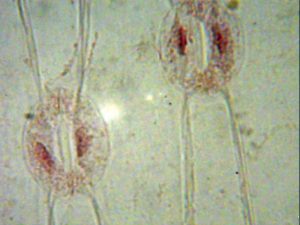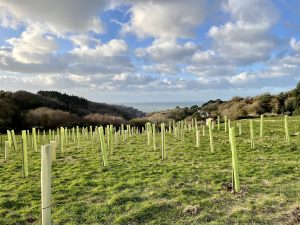Trees and the vagaries of climate.

During a drought, the trees in a woodland or forest become 'stressed' and may die. The reason for their death is not immediately obvious (beyond lack of water), and it is not possible to ‘transplant’ a mature tree and its complete root system to a lab for detailed investigations. However, recently, researchers at the University of Innsbruck have taken ‘the lab’ to a set of mature pine and pine trees.
The trees were fitted with rugged and waterproof ultra-sound detectors. Some of the trees had their canopies covered by a ‘roof’ so that the summer rain was denied to the trees, and they essentially experienced a ‘drought’. Drought stressed trees produce ultrasound ‘clicks’ (faint acoustic waves that bounce off of air bubbles) that can be picked up by the detectors. Air bubbles or emboli form in the vascular system of the trees when they are struggling for water.  Water is drawn up the xylem vessels by the evaporation of water (via the stomata) from the leaves, there is a continuous column of water. When the column of water breaks, bubbles form with the xylem vessels and the transport of water to the leaves is reduced. If the flow of water is substantially reduced the tree will die.
Water is drawn up the xylem vessels by the evaporation of water (via the stomata) from the leaves, there is a continuous column of water. When the column of water breaks, bubbles form with the xylem vessels and the transport of water to the leaves is reduced. If the flow of water is substantially reduced the tree will die.
The sound detectors found that the spruces produced more clicks than the beeches when water stressed, suggesting more emboli were formed within their xylem tissues. It may be that the beeches were able to access the deeper reserves of water in the soil, whereas the spruces had a shallower root system.
Trees can, of course, reduce water loss from their leaves by closing down their stomates.  But when their stomates are closed, they cannot take in carbon dioxide for photosynthesis and make the sugars / starch that they need for their metabolism. At the end of the experiment, the trees that experienced ‘drought’ were drenched with water and most recovered well, and their rates of photosynthesis caught up with the ‘control’ groups of trees (those with summer rain). However, the spruces’ water reserves were somewhat depleted; this was determined by measuring the resistance the tissues offered to an electrical current.
But when their stomates are closed, they cannot take in carbon dioxide for photosynthesis and make the sugars / starch that they need for their metabolism. At the end of the experiment, the trees that experienced ‘drought’ were drenched with water and most recovered well, and their rates of photosynthesis caught up with the ‘control’ groups of trees (those with summer rain). However, the spruces’ water reserves were somewhat depleted; this was determined by measuring the resistance the tissues offered to an electrical current.
The ability to withstand / recover from drought could over time affect the make up of woodlands and forests, particularly if the trend for hotter and drier summers continues.
Interestingly, some work in the United States (at University of Wisconsin–Madison)  suggests that young tree saplings that have experienced drought or heat are more likely to survive when transplanted into more challenging areas. It seems that the soil microbes that young saplings experience can help young trees establish themselves. Saplings grown in soil (and microbes) that have experienced drought / cold / heat are more likely to survive when later transplanted and faced with similar conditions. Trees with ‘cold-adapted’ microbes survived better when experiencing Wisconsin’s winter temperatures. The work was conducted with different species of tree in a variety of locations in Wisconsin and Illinois. The transplant locations varied in temperature and rainfall. It may be that fungi that inhabit the roots of the saplings are involved in these ‘responses’, though the microbial population of the soil is diverse.
suggests that young tree saplings that have experienced drought or heat are more likely to survive when transplanted into more challenging areas. It seems that the soil microbes that young saplings experience can help young trees establish themselves. Saplings grown in soil (and microbes) that have experienced drought / cold / heat are more likely to survive when later transplanted and faced with similar conditions. Trees with ‘cold-adapted’ microbes survived better when experiencing Wisconsin’s winter temperatures. The work was conducted with different species of tree in a variety of locations in Wisconsin and Illinois. The transplant locations varied in temperature and rainfall. It may be that fungi that inhabit the roots of the saplings are involved in these ‘responses’, though the microbial population of the soil is diverse.
For more details of this work, follow the link here.
Comments are closed for this post.
